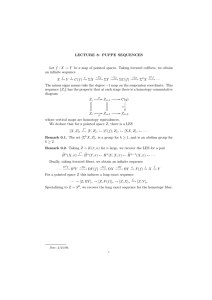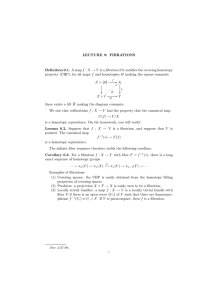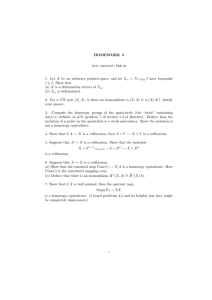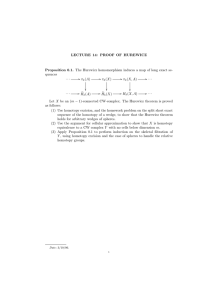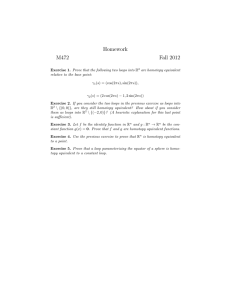Homework Eight
advertisement
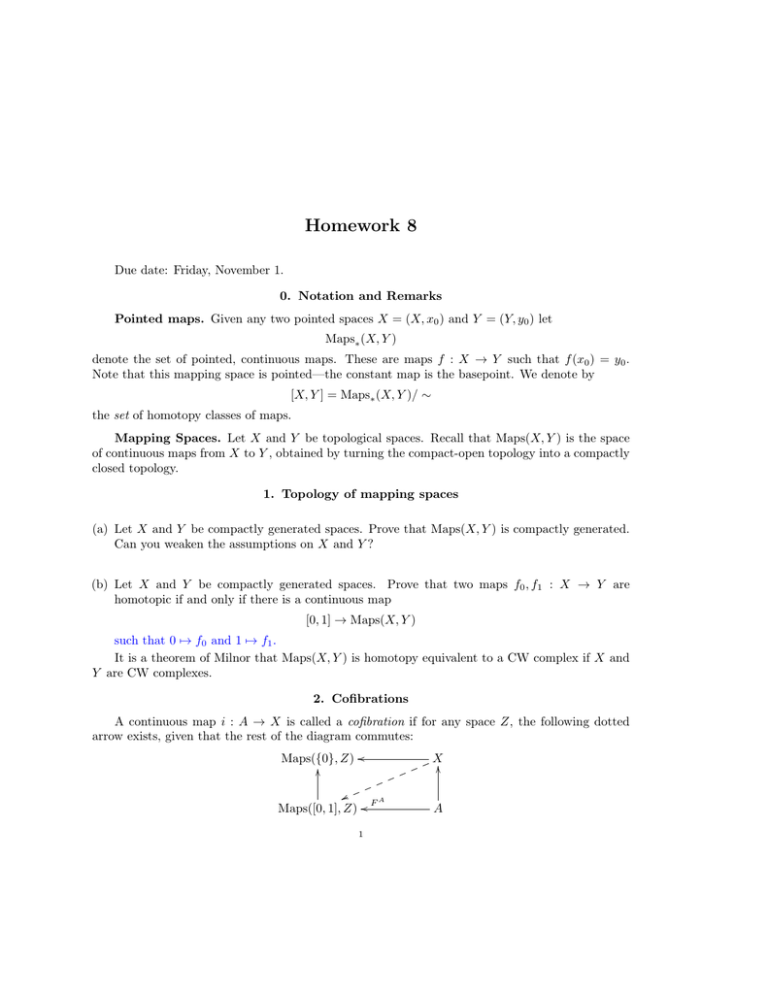
Homework 8
Due date: Friday, November 1.
0. Notation and Remarks
Pointed maps. Given any two pointed spaces X = (X, x0 ) and Y = (Y, y0 ) let
Maps∗ (X, Y )
denote the set of pointed, continuous maps. These are maps f : X → Y such that f (x0 ) = y0 .
Note that this mapping space is pointed—the constant map is the basepoint. We denote by
[X, Y ] = Maps∗ (X, Y )/ ∼
the set of homotopy classes of maps.
Mapping Spaces. Let X and Y be topological spaces. Recall that Maps(X, Y ) is the space
of continuous maps from X to Y , obtained by turning the compact-open topology into a compactly
closed topology.
1. Topology of mapping spaces
(a) Let X and Y be compactly generated spaces. Prove that Maps(X, Y ) is compactly generated.
Can you weaken the assumptions on X and Y ?
(b) Let X and Y be compactly generated spaces. Prove that two maps f0 , f1 : X → Y are
homotopic if and only if there is a continuous map
[0, 1] → Maps(X, Y )
such that 0 7→ f0 and 1 7→ f1 .
It is a theorem of Milnor that Maps(X, Y ) is homotopy equivalent to a CW complex if X and
Y are CW complexes.
2. Cofibrations
A continuous map i : A → X is called a cofibration if for any space Z, the following dotted
arrow exists, given that the rest of the diagram commutes:
Maps({0}, Z) o
O
XO
v
Maps([0, 1], Z) o
1
FA
A
2
HOMEWORK 8
This means that any homotopy of A extends to a homotopy on all of X.
(a) Let f : X → Y be any continuous map. Show that
X → Mf ,
x 7→ (x, 0)
is a cofibration. Recall that Mf is the mapping cylinder, defined to be
a
(X × [0, 1]
Y )/(x, 1) ∼ f (x).
(As a hint: Try using the technique from a previous homework, which shows that a certain
subspace is a (not necessary deformation) retract of a product space).
(b) Show that any continuous map f : X → Y factors as a cofibration, followed by a homotopy
equivalence:
X ,→ M ' Y
(c) State in one sentence, using previous homework, why the continuous map X k → X of including
the k-skeleton into a CW complex is a cofibration.
(d) Let f : X → Y be any continuous map between pointed spaces. The homotopy cofiber of f is
defined to be the colimit (in the category of spaces) of the diagram
X
/ Mf .
∗
If f : X → ∗ is the constant map, find the homotopy cofiber of f . It is a space you’ve studied
before.
3. Fibrations
A continuous map p : E → B is called a fibration if for any space Y , the following dotted arrow
exists, given that the rest of the diagram commutes:
Z
(y,0)
Z × [0, 1]
/6 E
p
/B
This means that any homotopy of Z occurring in the base B can be lifted to the space E.
(a) Let f : X → Y be any continuous map. Let
Nf := X ×f Maps([0, 1], Y ) = {(x, γ) such that γ(0) = f (x)}
4. BASED LOOP SPACES AND SUSPENSION-LOOP ADJUNCTION
3
be the mapping path space of f . As a set, it is as indicated. As a space, we take the subspace
topology inherited from X ×Maps([0, 1], Y ), then we apply the functor k to make it a compactly
generated space.
Show that the map
Nf → Y,
(x, γ) 7→ γ(1)
is a fibration.
(b) Show that Nf is homotopy equivalent to X.
(c) Show that any continuous map f : X → Y factors as a homotopy equivalence, followed by a
fibration:
X ' N → Y.
(d) Fix a map f : X → Y of pointed spaces. The homotopy fiber of f is the limit (in the category
of spaces) of the following diagram:
Nf .
∗
/Y
If f : ∗ → Y is the map to the base point of Y , find the homotopy fiber of f . You may see this
space again during this homework.
4. Based loop spaces and suspension-loop adjunction
Define the based loop space of X to be the topological space
ΩX := Maps∗ (S 1 , X).
Recall that subspaces of a compactly generated space may not be compactly generated, so by the
above, we mean the k-ification of the subspace. It’s a theorem of Milnor that if X is homotopy
equivalent to a CW complex, so is ΩX. Note that ΩX has a natural basepoint, called the constant
loop at x0 .
You may take for granted that Ω defines a functor from pointed spaces to pointed spaces. On
maps, a map f : X 0 → X is sent to map ΩX 0 → ΩX in the obvious way: post-composing a loop
into X 0 by f .
(a) Let X, Y, Z be compactly generated spaces. Prove there is a homeomorphism of spaces
Maps (X ∧ Y, Z) ∼
= Maps (X, Maps (Y, Z)).
∗
∗
∗
(b) Let X and Z be compactly generated. Show there is an isomorphism of sets
[ΣX, Z] ∼
= [X, ΩZ]
4
HOMEWORK 8
where ΣX is the reduced suspension.
5. Homotopy Groups
(a) Let Ωn Y = Ω . . . ΩY , where Ω is performed n times. Show that for all n, there is an isomorphism
of sets
∼ πn Y.
π0 (Ωn Y ) =
(b) Show that for all n, there is an isomorphism of sets
[Σn (S 0 ), Y ] ∼
= πn Y.
(c) Show that if Y is a compactly generated, connected space, then you can recover all the homotopy
groups of Y by knowing all the homotopy groups of ΩY , and vice versa. There’s a subtlety
involved for π0 ΩY . You can simply state that there’s a bijection of sets in this case, if you like.
6. Covering Spaces
A map p : E → B is called a covering, or a covering space if it is a surjection, and if for each
b ∈ B, there is an open neighborhood b ∈ Ub ⊂ B such that each connected component of p−1 (Ub )
is open in E, and is mapped homeomorphically onto Ub by p.
Example. Let p : R → S 1 be the map sending t 7→ ei2πt . Then any connected, open arc U on
S has preimage p−1 (U ) consisting of a disjoint union of connected open intervals, each of which is
homeomorphic to U under the projection map.
This local homeomorphism property makes the world go round when we’re dealing with covering
spaces, as we’ll see.
1
(a) Let p : E → B be a covering space. For any x ∈ E, b = p(x), show that any path γ : [0, 1] → B
with γ(0) = p(x) has a unique lift to E. (Hint: We did a “non-unique” version of this in class
for vibrations.)
(b) Let p : E → B be a covering space with B path-connected. Show that p is a Serre fibration.
(Hint: Is p a fiber bundle?)
(c) If p : E → B is a covering space, show that the lifting (i.e., the dotted arrow) guaranteed by
the homotopy lifting property must be unique.
7. AN APPLICATION OF YOUR SOLUTIONS TO THE COVERING SPACE PROBLEM
5
7. An application of your solutions to the covering space problem
(a) Let p : E → B be a covering space. Assume E and B are path-connected and locally contractible. Show that there is an isomorphism
∼ πn (B)
πn (E) =
for all n ≥ 2.
(b) Given that the real line is a covering space of S 1 , compute πn (S 1 ) for all n ≥ 2.
(c) Show that if p1 : E1 → B1 is a covering space, and p2 : E2 → B2 is a covering space, then the
map
E1 × E2 → B1 × B2 ,
(e1 , e2 ) 7→ (p1 e1 , p2 e2 )
is a covering space.
(d) Show that for all k ≥ 0, the k-torus T k := S 1 × . . . S 1 has vanishing higher homotopy groups.
That is,
πn (T k ) = 0
whenever n ≥ 2.
(e) More generally, if any space X admits a covering space E → X where E is contractible, show
that
πn (X) = 0
for all n ≥ 2.
